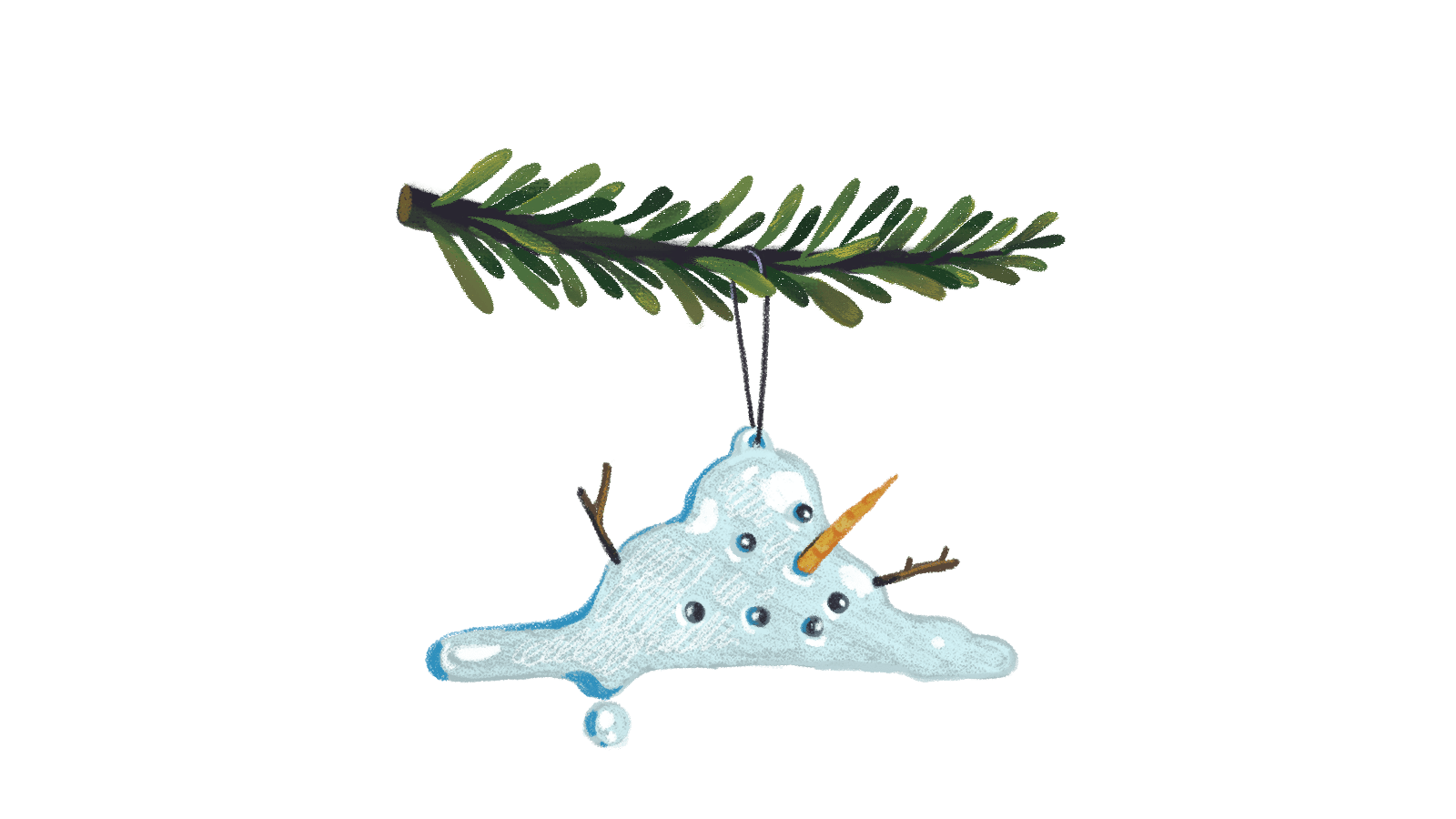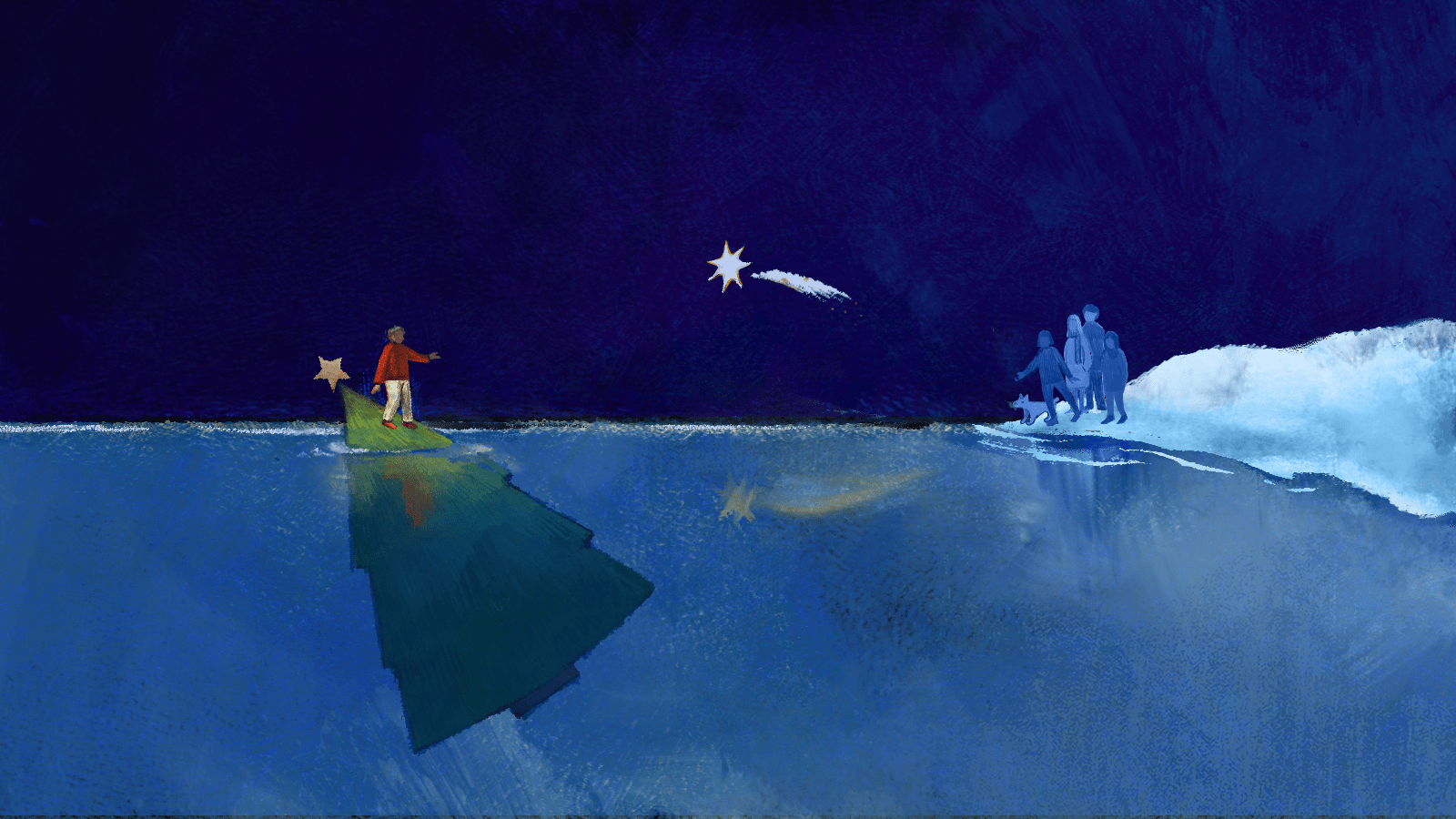I was 11 years old the year my older stepsister brought her high school boyfriend home for the first time. It was Thanksgiving in 2006, and his Southern manners fit right in as we bantered between mouthfuls of cornbread stuffing, fried okra, and marshmallow-topped sweet potato casserole. Then, in the overstuffed lull before the desserts were served, my dad plunked his laptop in the center of the table. He opened it up and began clicking through a PowerPoint presentation chock full of data on ice sheet melt and global atmospheric carbon dioxide concentration.
My stepsister’s eyes grew wide with embarrassment. In an effort to welcome her sweetheart to the family, my dad had rolled out his version of a red carpet: one of his many family lectures on the horrors of climate change.
This wasn’t the first — or last — time my dad’s climate obsession took center stage at our family gatherings. On that particular occasion, he was doling out factoids about Arctic amplification — the prevalence of which was then a debate among climate scientists. It was just a warm-up to a typical holiday season spent quibbling over the ethics of farmed Christmas trees and openly scoffing at scientific inaccuracies during a movie theater showing of Happy Feet, the year’s seasonal offering about a dancing penguin named Mumble. A month later, on Christmas Eve, he forwarded me an email about how Santa Claus’ body would disintegrate if he were to travel through the atmosphere at the speeds necessary to meet his seasonal duties, adding a personal note: “Not to mention the emissions!”
Over the years, these tendencies earned him the family nickname “Dr. Doom” — a nod to his university professor title and compulsive need to share terrifying facts about our warming world. My dad hammed it up, interrupting his own lamentations by hooting out, “We’re all gonna die!” in a cartoonish falsetto. More than anything, it was a term of endearment. After all, we knew other households that spent their holidays arguing over whether climate change was even real.
Many of us know a Dr. Doom in our lives, or at the very least, a pessimist with a particular fixation. We each have our own ways of responding to it, such as my brother’s pragmatism, my stepmom’s knee-jerk optimism, my stepsister’s exasperation. Or, perhaps you are the doomer yourself.
I’m usually tempted to respond with, “I see hope in the next generation.” But doomerism — a label often used to describe climate defeatists — doesn’t typically leave room to talk about a better future. It’s a contagious kind of despair, often too credible to dismiss. Nowadays, my brother and I both work in climate-related fields, undeniably thanks to Dr. Doom’s influence. But growing up, it only took a few days of dad’s soapboxing before I’d tune out of anything climate-related until the New Year.
This Christmas, as we once again prepare to pass around the cranberry sauce and discuss the end of the world, I can’t help but wonder how my dad became Dr. Doom. And in a world of rising doomerism, what influence do such tidings have on others?
My dad’s journey to becoming “Dr. Doom” started with his formal training as a tropical ecologist. Until the early 2000s, his work meant trudging through rainforests, studying photosynthesis while battling mosquitoes. Then, the wear of human activity on his surroundings became too much to bear. He switched gears and has since spent his career leap-frogging between climate education jobs — from director of an environmental science program at the University of Idaho to president of a small school in Maine, which, in 2012, he led to become the first college to divest fully from fossil fuels.
Those entrenched in science, like my dad, seem to be especially susceptible to climate despair. That’s according to experts like Rebecca Weston, the co-executive director of the Climate Psychology Alliance of North America, a community of mental health professionals trained to address the emotional and psychological challenges emerging in our warming world. Many in scientific fields, Weston says, are first to document and review the data behind irreversible loss.
The facts of the crisis are so dire that despair seems to be a hazard for many — scientists or not. After all, a study by researchers at the Yale Program on Climate Change Communication found that some 7 percent of U.S. adults report potentially serious levels of psychological distress about climate change. Gale Sinatra, a professor of psychology at the University of Southern California’s Rossier School of Education who studies how people learn about climate change, put it more simply: “Your dad’s problem is that he knows too much.”
The issue only gets worse when the climate-informed try to share what they know. In a short-lived position in 2007 as science advisor to the Florida state government (back when then-Governor Charlie Crist would actually acknowledge “climate change”) my dad was silenced during a presentation to the Legislature. A report later said that the “awkward” situation arose when a Republican senator took issue with a discussion topic that “had not yet been accepted as fact.” According to my dad, the controversy stemmed from his decision to share the famous “hockey stick” graph, a data visual that shows that global average temperatures began spiking after human societies industrialized.
“We’re starting to understand it as moral injury,” said Kristan Childs, co-chair of a committee to support climate scientists with the Climate Psychology Alliance, referring to a psychological phenomenon that happens when people witness actions that violate their beliefs or damage their conscience. “They’ve been informing people for so long, and there’s just such a betrayal because people are not believing them, or are not doing enough to act on it.”
Like many, my dad’s response to this was to get louder — and darker. There’s conflicting research on how different kinds of messaging can affect peoples’ behavior. Some studies show that those experiencing distress are also more active, while others say that emphasizing worst-case scenarios, like so-called climate “tipping points,” is an ineffective strategy that can overwhelm and demotivate audiences instead. It can also backfire on a personal level: Listeners of the podcast “This American Life” may be familiar with a story about a climate activist dad whose zeal led to his children cutting him out of their lives.

As a journalist on the climate beat, I’ve interviewed dozens of self-described “doomers,” and yet I’ve found the term is a bit of a misnomer. While many fixate on the worst possible climate scenarios, they’re generally not quitters. As Childs put it, “I don’t know anyone who’s just given up on it all.” Instead, nearly all have dedicated their lives to addressing climate change. And they can’t help but evangelize, warning everybody within earshot of the ways the coming century could change their lives.
Throughout these interviews, I’m tacitly looking for any insight that might help my own Dr. Doom. (Recently, I accompanied my dad to a physical therapy appointment where, upon seeing a disposable blood pressure cuff, he attempted to regale his doctor with facts about the greenhouse gas emissions associated with the U.S. healthcare system.) Childs might just have one. She offers a 10-step program for professionals who work in science-oriented fields, affiliated with a larger collection of support groups offered by the Good Grief Network, a nonprofit organization dedicated to processing emotions on climate change.
“The group work is powerful because it really, really helps dissolve the sense of isolation,” Childs said. As she spoke, I shifted uncomfortably, wondering how many times my teenage tendency to tune out or respond flippantly made my dad feel I was invalidating his concerns.
The best place to start is often the hardest: acknowledging how bad the problem is. “It’s actually helpful to give people a place to share their biggest fears,” she said, adding that the typical workplace culture in scientific fields discourages expressing emotions. “Somehow some acceptance of how bad it is, and the fact that we can then still stay engaged, shifts the question to who we can be in these times.”
Weston agrees that entirely erasing climate anxiety isn’t realistic, especially as the effects of Earth’s changing atmosphere become more apparent and frightening. Instead, her group suggests reframing ideas of what having a meaningful impact looks like. “It depends on breaking through a kind of individualist understanding of achievement. It’s about facing something that will be resolved past our own lifetimes,” she said.
My dad has spent his career chasing that elusive sense of fulfilment — never quite satisfied with the work he’s doing. But lately, he’s found a reason to stay put. In 2019, he returned to my hometown to teach climate change to undergraduates at the University of Florida. Now and again, I’ve wondered how these 18- to 22-year-olds, many of whom grew up in the increasingly red state, respond to his doomsaying. This year, while home around Thanksgiving, I sat in on his last lecture of the semester — a doozy on how economic systems can destroy natural resources. His students seemed completely at ease — chatting with him at the beginning of class, easily participating when he asked questions. I was already surprised.
“He’s just sharing the facts,” one of his students told me, when I asked a group of them about his teaching style after the class.
Another quickly interjected: “He’s too dogmatic. It’s super depressing, it’s super doom.” Others nodded.
A third chimed in: “It helps me feel motivated.”
Later that week, while I was reporting a different story at a local climate event, both his former students and local activists flagged me down to say how much they appreciated my dad’s courses and op-eds in local newspapers.
“We need all sorts of climate communication. People are responsive to different messages,” said Ayana Elizabeth Johnson, the markedly anti-doomer author of What If We Get It Right?, a recent book that puts possibility at the center of climate action. In 2019, a Yale study on how people respond to different messaging tactics underscored this point — finding that “hope is not always good, and doubt is not always bad.”
For Johnson, getting through the climate crisis starts with who you surround yourself with. “This is not solitary work. Individual changemakers are not really a thing,” she said. “We never know the ripples that we’re going to have.”

The Christmas stockings on the mantle at my dad’s house haven’t changed in years, but the dinner conversations have. Now, Instead of trying to brush aside Dr. Doom’s digressions, we lean in. Our evenings are spent butting heads over the recent climate optimism book, Not the End of the World, by data scientist Hannah Ritchie; swapping notes on heat pumps; and debating how to make the most of used-EV tax credits. My baby nephew, Auggie, the latest generation to be saddled with our hopes and fears, brightens the room with his cooing at all manner of round fruits and toy trucks.
Between sips from warm mugs, my dad leans back in his chair and frowns at some news on his phone’s screen. “The wheels are really coming off the wagon, kids. Humanity faces an existential threat,” he says, to no one in particular. From the next room, my step mom calls, “The sky’s been falling since I met you, Stephen.”
It’s hard not to smile. Who knows how many people my dad has influenced, or if he will ever feel satisfied with his mission. But as his doomy, gloomy self, he’s built a community and family that shares his values. At that moment, I find myself thinking of something Childs told me: “You cannot protect your kids from climate change. But you can protect them from being alone with climate change.”
In our changing world, these conversations feel like something to be thankful for.
Source link
Sachi Kitajima Mulkey grist.org

